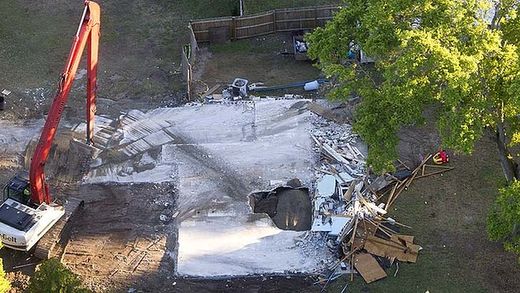In recent weeks, a spate of those bad-dreams-come-true have drawn national attention when the earth seemingly swallowed a man in his Florida bedroom and a golfer in Illinois.
After the widespread coverage of those sinkholes and others, some experts say the phenomena may be scarier in thought than reality.
Only about 20 percent of the country has underground geology that favors the formation of natural sinkholes, the U.S. Geological Survey says. But in developed areas, any pipeline or sewer can collapse in the right circumstances.
"I'd guess there is this primal fear of being swallowed up by the earth and taken to hell,'' said Paul Greene, an associate professor of psychology at Iona College in New Rochelle, N.Y., who works with disaster victims.
"I recall scenes from the movie Ghost when the evil characters die and their souls are taken down in the ground by demons.''

At the USGS, geologist Randall Orndorff says sinkholes are more common than laymen realize. "They form in fields and woods every day and no one notices except the land owner. They can be a hazard and we want people to know about them."
In some areas, like Florida, the holes are widely studied and mapped; elsewhere, only those that cause structural damage to a building or road get noted.
"There's no master database of them, but there's no reason to think any more of them are forming," Orndorff said. "There's no sinkhole season."
Comment: There may be no official record-keeping, but SOTT.net has been tracking them for years - sinkholes are clearly happening more and more often.
The USGS hopes to issue later this year the first national interactive map that people can click to see if their property may be in sinkhole country, with links to state resources for more detail, Orndorff said.
Comment: SOTT.net forum members are already on the case. The following Google Map documents all significant sinkholes (that is, sinkholes that are clearly not just your average potholes) from August 2012 to date:
The basic ingredients of sinkholes are water - or sometimes the lack of it - and soil or rock that's easily eroded underground. Acidic rainwater slowly melts away soft rock such as limestone or salt or dolomite. The removal of groundwater creates voids. Either way, the overlying soil sinks.
Comment: If sinkholes can happen in the absence of excess rainwater, then clearly water cannot be a 'basic ingredient'.
Several recent sinkhole deaths have been tied to human activity. Two water-well drillers in Florida died in 2011, when their rigs broke through the roof of a cavern. Also that year, a Bakersfield, Calif., oil worker died in a sinkhole near a well where state officials noted steam had been used for several years to drive crude to the surface.
In Idaho last July, a woman died when she drove her car into a collapsed roadway. Officials later determined that gophers digging nearby had created channels that caused rainwater to undermine the highway.
But it was last month's death of Jeff Bush in his bedroom in a suburban Tampa home that has put sinkholes in the spotlight of media and social media.
"When something like this happens, it seems like it's out of the blue and makes people wonder if they're susceptible,'' said Russell Jones, a psychology professor at Virginia Tech who studies disaster stress. "People need to be aware of the probability of this actually happening to them before they respond in a frightful or arbitrary way."
Recent media reports and Twitter threads in the past two weeks discussed other sinkholes in Florida; Pennsylvania (including one that drained a duck pond) and Louisiana. A memorable collapse on a Waterloo, Ill., golf course swallowed a quarter of a foursome: a 43-year-old mortgage banker who dislocated a shoulder and had to be pulled out by his friends with a makeshift rope.
The Louisiana sinkhole, the 9-acre result of a collapsed salt dome near Bayou Corne that began last year, has displaced about 350 people and drawn a visit from environmental activist Erin Brockovich.
Curiously enough, a 2000 made-for-television movie titled On Hostile Ground was also set in Louisiana, with the premise that New Orleans was about to be swallowed by a giant sinkhole on the eve of Mardi Gras.
And a 2003 short film titled Sinkhole, was shot in part around the mostly abandoned town of Centralia, Pa., which has been smoldering and collapsing from an underground coal fire for more than 50 years.
Yet aside from a few appearances in Star Wars films and earthquake flicks and generations of quicksand scenes, the cinematic potential that may lurk beneath our feet remains mostly untapped.
But some observers also see increasing reports of sinkholes as harbingers of greater disasters. They chronicle the events as pointing to the Apocalyse on sites such as: http://endtimesrevelations.wordpress.com/category/sinkholes/
Source: Scripps Howard News




Comment: If sinkholes can happen in the absence of excess rainwater, then clearly water cannot be a 'basic ingredient'.
If the geologic formation involved is limestone, then water is what causes the solution cavities to form in the bedrock. Where there are joints in the rock structure, water flows and, over time, dissolves the parent rock. It's water that causes the solution cavities in the rock. Above that rock there is soil overburden, which is either deposited sediment or weathered from the parent rock.
In that soil overburden, changes in the groundwater regime can accelerate the transport of soil downward into the solution cavities. Once there is a hole in the roof of the limestone cave, the soil can seep in, but soil has a tendency to 'arch' which is a physically measurable phenomenon and that is commonly relied upon in complex soil mechanics, or geotechnics (as a practicing geotechnical engineer and licensed professional engineer, this is what I do every day....when I'm not reading sott.net) for the design of earth structures (my particular specialty).
Think of an hourglass. If the hole is small enough, even when bigger than the smallest sand grains, the soil can jam up in the hole. It can happen that, like a stone-arch bridge, the soil particles arch over even a large hourglass opening that is many diameters larger than the sand grains. There is a practical limit to this arching. Now imagine that the hourglass is full of damp sand. It will clump together due to the suction forces between soil grains, and that arching can be larger than if it were completely dry sand.
Now back to the sinkhole overburden. When it's wet, it can clump together and clog the hole in the limestone roof better. When it dries out, say in a drought, that can trigger sudden collapse of the soil overburden into the limestone that was previously dissolved by water.
Sinkholes are also common in areas of previous mining activity, so not all are formed by water. Though the same wetting and drying cycle of the overburden can trigger surface collapse.
Another mechanism for ground collapse is due to consolidation of deep sediments. When they are wet, they are 'buoyant' to some degree. When groundwater is lowered, the ground settles due to the reduced buoyancy effect and also due to the weight of the soil overburden squeezing the latent moisture out from between soil grains. In areas where aquifer pumping is exceeding rainfall recharge, there can be massive subsidence of land over many square miles. That is what is happening in Mexico City.
When you get such huge areas of land subsidence, the unpredictable can happen. Fissures can develop below the ground surface due to variation in geologic bedding, stresses and strains built into the soil structure, previous areas of higher permeability where groundwater may have been more apt to flow, etc. So the massive subsidence, which can be caused by drying events, can absolutely trigger sinkholes.
None of this is to refute the implication (often supported by sott.net?) that sinkholes are appearing more. That may be the case. This is just to suggest that drawing inferences where there is no expertise is not good journalism.